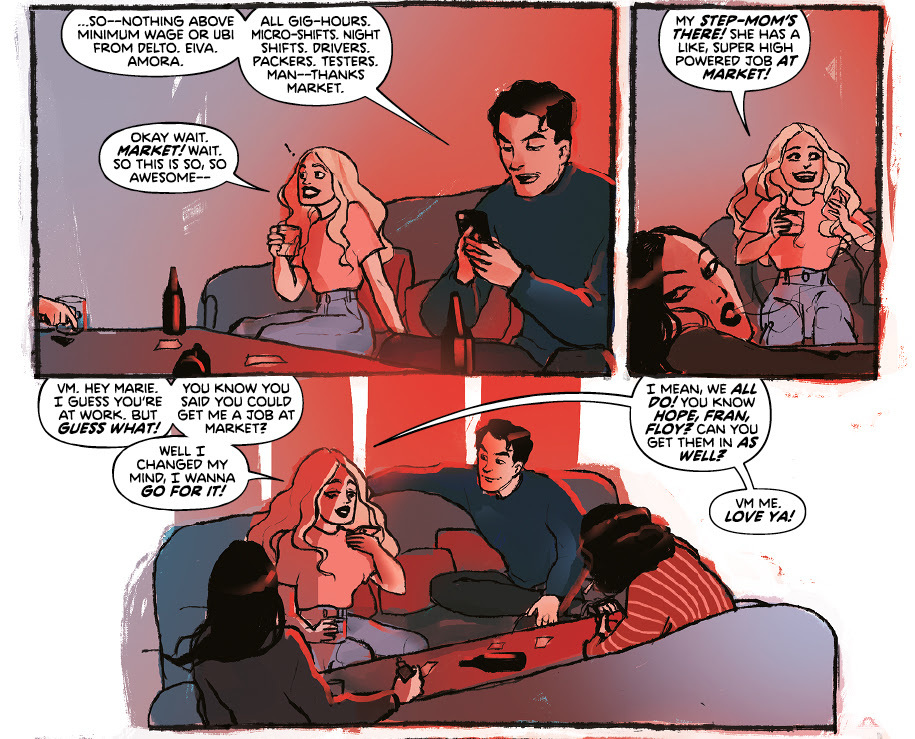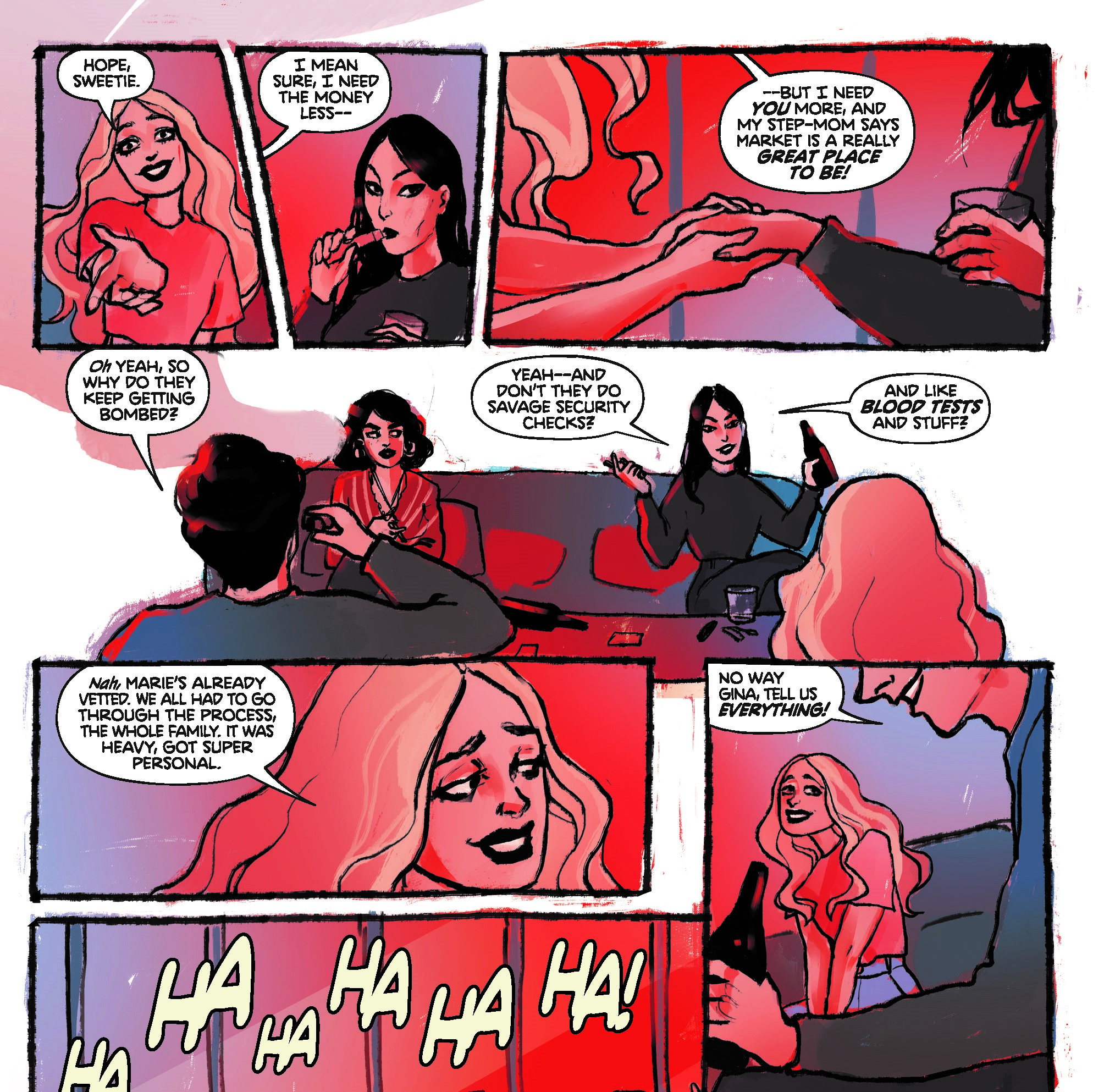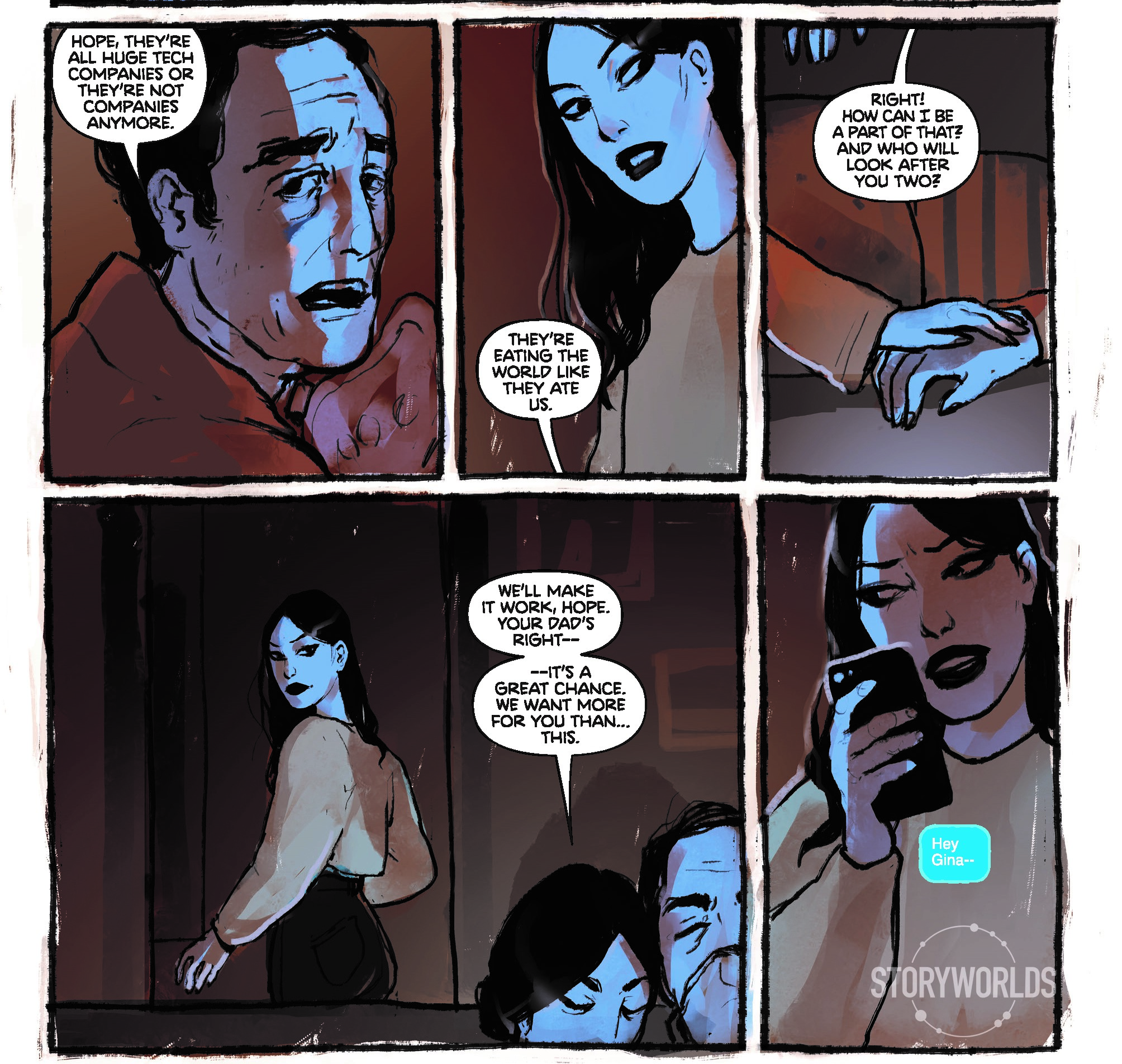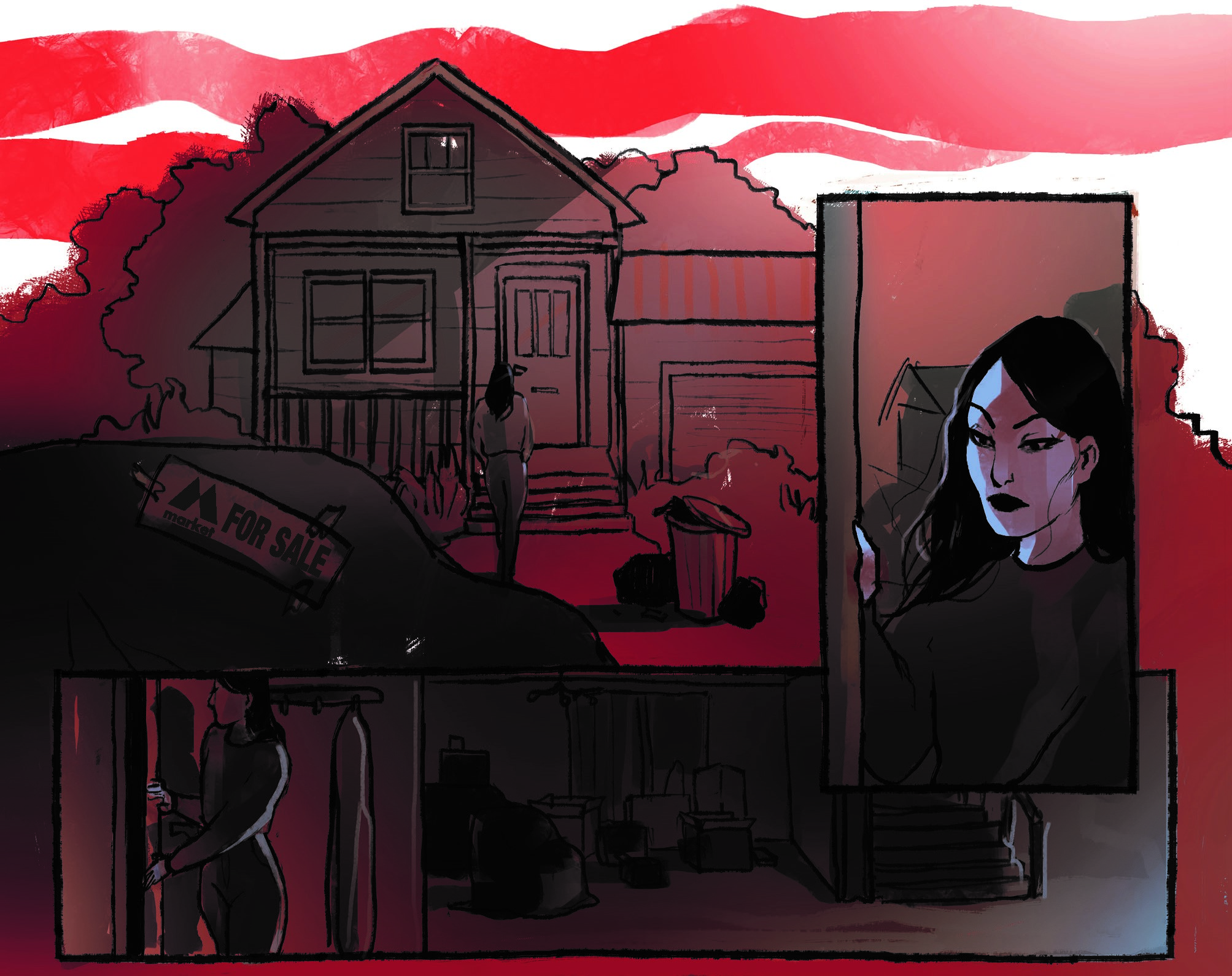Table of Contents Show
Words like “conspiracy” and “fearmongering” too often occupy present-day vernacular, and Only Hope: Fear Farm offers a fictional consideration of manipulations. New indie publisher StoryWorlds Media‘s Only Hope launches readers into a tale about a young woman named Hope who takes a job working in internet content moderation for a propitious tech company, Market. Midway through the sixty-page graphic novella, tonal horror creeps in. Hope untangles the alarming truths and debunks the conspiracies lurking inside the Market buildings’ inaccessible rooms. In this review, we’ll unpack the thematic intricacies of the story in Only Hope: Fear Farm and how the artistic style perfectly suits the plot’s escalating terror. Only Hope was created by writer Max Gadney, illustrator Ksenia Kudryavtseva, and letterer Taylor Esposito.
Facing Fear Behind Closed Doors
Only Hope opens on a familiar scene: A group of friends in their twenties discusses their reasonable fears about working in the relentless rat race for horrible bosses, minimal pay, and long hours. Hope Farrar is especially cynical about subjecting herself to debasing work environments. The continual harassment about finding employment Hope’s parents subject her to exacerbates Hope’s indifference toward the workforce. However, Hope’s father suffers from an illness, and she feels compelled to stay at home as long as possible to care for her parents. When Hope’s exuberant — and well-connected — friend Gina secures positions at tech company “Market” for her entire friend group, Hope’s parents encourage her not to pass up the opportunity.
Flown to an isolated island in the Pacific, Hope, Gina, and her best friends all feel enthusiastic about working in social media for Market. After their arrival, a fast-talking man named Mason briefs the young adults on the intricacies of their jobs as moderators for online content creation. Mason explains how their current location is only one of the forty-seven buildings in Market’s company, dubbed global content “farms.” At Market, employees are required to give up their phones for substituted — and monitored — work phones, instantly causing phone-addicted Gina to react poorly. Mason then briefs the friends about completing onboarding profiles, achieving personalized targets, and receiving evaluations.

Gina and Hope’s initial eagerness about becoming co-workers ebbs when Mason announces that Gina receives an automatic promotion due to her stepmothers’ current involvement in Market. Three levels of content moderation divide jobs physically in the building, beginning with media moderators on the lower floors, society moderators in the second category, and the most intense tier of government content moderators — or “two-hundred percenters” — locked away on the highest floor. Consequently, Gina’s isolation from Hope immediately distresses the two women. Gina video chats with Hope, divulging the terrors of content she is forced to filter through for online websites. When Hope stops hearing from the visibly frightened Gina altogether, Hope suspects a conspiracy in the Market building.
Hope’s advancement to the top level, red tier content unsheathes psychological horrors upon her each day. Misinformation and fearmongering material on social media sites aren’t merely available for the general public: The content is carefully curated by employees at companies like Market. Unfortunately, the conspiracies online are nowhere near equivalent to the abhorrent conspiracies circulating within Hope’s place of employment. In Only Hope: Fear Farm, Hope is determined to pry open the metaphorical and physical doors concealing the truth in Market’s fear farm.
Only Hope Delivers On Its Relevant Premise
Only Hope: Fear Farm uses its expanded page count to elaborate on what could have been a cut-and-dry story devoid of nuance. Instead, the comic takes current events into account and adopts an organic sentiment. The story flows naturally, plodding along at a contenting pace that allows each event to feel consequential. Max Gadney nails the genuineness of the written dialogue spoken between the young adult friends. Thankfully, he avoids excessive slang, opting to pepper Gina and Hope’s conversations with an appropriate touch of modern colloquialisms. As a result, dialogue comes across as both conversational and sentimental. Gadney’s awareness in this aspect is much appreciated, as many writers tend to go overboard on trying to make younger characters sound “with the times,” so to speak.
We are living in an era where nearly all of society essentially depends on technology and consumerism. With unrestricted user control over content, anyone with a phone has unfettered access to anything available on the worldwide Web. Only Hope explores the elusive — and often manipulative — facets of content creation. Creatively, Gadney challenges the basic premise of “most of what you see on social media is a facade” by focusing the narrative not on the content creators but the corporation-controlled content moderators. The socially conscious themes strike a relevant chord during our social-media-influenced present era. Only Hope offers a widened frame of reference, scrutinizing the conspiratorial misinformation and fearmongering created through social media.

Protagonist-wise, Hope is entirely relatable without diving into cliched character tropes. Her intuitiveness tempers any audience ill-will toward her hilariously sarcastic attitude. Additionally, Only Hope parses morality through its themes and its character responses. Hope’s morals aren’t nebulous, yet her morals are challenged. Readers can empathize with Hope’s fear and draw introspective conclusions about how they might react in similar situations. While the positive aspects of Only Hope far outnumber the negatives, there is a slow point disrupting the narrative movement. When Mason takes the group on their introduction orientation, a bit of an information dump is thrust upon readers. Processing this expository information may drag the story for readers struggling to digest new terminology. Only Hope avoids feeling convoluted for the most part, apropos of the explanatory information about Market’s operations.
Subtext Flourishes Through Illustrations
Horror in the comic medium works best when the visual and spatial elements coalesce with the dialogue’s auditory implications. Only Hope: Fear Farm shifts from a tone of pleasant doldrums to menacing terror gradually, edging the reader slowly closer into discomfort. Due to Ksenia Kudryavtseva’s artistic choices working in tandem with Gadney’s script, horror is dispensed palpably throughout the graphic novella. Kudryavtseva’s art style feels loose and approachable. Colors sometimes drift into panel gutters, evincing the precursory tone of nonchalance Hope experiences about job-hunting. The loose marker appearance and boundary-crossing coloring later become representative of Market’s inability to cover up the conspiracies leaking out from the cracks of their posturing interior.

Inside Market, the physicality of the images appears weightier. Tech objects hold visual three-dimensional depth that seems to overshadow the growing two-dimensionality of the illustrated characters. Glowering red tones in the Market workplace visibly announce warning signs. Blue colors induce a clinical atmosphere, making the reds stand out conspicuously. Taylor Esposito’s lettering adapts with the changing hues in Only Hope. Text messages and words on the screen emerge from brightly colored backdrops. Pertinent to the narrative, Esposito changes fonts in accordance with the different types of tech in use. Esposito’s computerized typefaces operate as a touchstone of a comic steered by a technology-based narrative. The ocular constituents of Only Hope: Fear Farm convey the subtext incisively.
Only Hope Allows Accessible Learning
Only Hope: Fear Farm aims itself at readers during a time of great social and political intrigue. Honing in on themes about the masquerade of social media from every point of contact, the comic allows its audience to reflect on how we consume and interact with content online. Furthermore, Only Hope is a comic accessible to a mass audience. The messages present are direct. Narratively and artistically, the comic is straightforward as not to cause any confusion in communicating its ideas. Any literature or work of art aims to provoke a reaction, and this comic uses its sixty pages to teach, frighten, and entertain. Only Hope caters to broad audience appeal with a story relevant to today. The pages blossom with intrigue, refusing to dance around the heart of its poignant subject matter.
